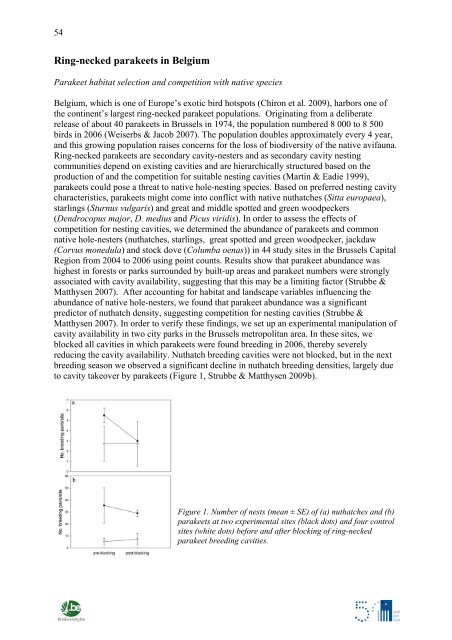Science Facing Aliens - Invasive Alien Species in Belgium - Belgian ...
Science Facing Aliens - Invasive Alien Species in Belgium - Belgian ...
Science Facing Aliens - Invasive Alien Species in Belgium - Belgian ...
Create successful ePaper yourself
Turn your PDF publications into a flip-book with our unique Google optimized e-Paper software.
54<br />
R<strong>in</strong>g-necked parakeets <strong>in</strong> <strong>Belgium</strong><br />
Parakeet habitat selection and competition with native species<br />
<strong>Belgium</strong>, which is one of Europe’s exotic bird hotspots (Chiron et al. 2009), harbors one of<br />
the cont<strong>in</strong>ent’s largest r<strong>in</strong>g-necked parakeet populations. Orig<strong>in</strong>at<strong>in</strong>g from a deliberate<br />
release of about 40 parakeets <strong>in</strong> Brussels <strong>in</strong> 1974, the population numbered 8 000 to 8 500<br />
birds <strong>in</strong> 2006 (Weiserbs & Jacob 2007). The population doubles approximately every 4 year,<br />
and this grow<strong>in</strong>g population raises concerns for the loss of biodiversity of the native avifauna.<br />
R<strong>in</strong>g-necked parakeets are secondary cavity-nesters and as secondary cavity nest<strong>in</strong>g<br />
communities depend on exist<strong>in</strong>g cavities and are hierarchically structured based on the<br />
production of and the competition for suitable nest<strong>in</strong>g cavities (Mart<strong>in</strong> & Eadie 1999),<br />
parakeets could pose a threat to native hole-nest<strong>in</strong>g species. Based on preferred nest<strong>in</strong>g cavity<br />
characteristics, parakeets might come <strong>in</strong>to conflict with native nuthatches (Sitta europaea),<br />
starl<strong>in</strong>gs (Sturnus vulgaris) and great and middle spotted and green woodpeckers<br />
(Dendrocopus major, D. medius and Picus viridis). In order to assess the effects of<br />
competition for nest<strong>in</strong>g cavities, we determ<strong>in</strong>ed the abundance of parakeets and common<br />
native hole-nesters (nuthatches, starl<strong>in</strong>gs, great spotted and green woodpecker, jackdaw<br />
(Corvus monedula) and stock dove (Columba oenas)) <strong>in</strong> 44 study sites <strong>in</strong> the Brussels Capital<br />
Region from 2004 to 2006 us<strong>in</strong>g po<strong>in</strong>t counts. Results show that parakeet abundance was<br />
highest <strong>in</strong> forests or parks surrounded by built-up areas and parakeet numbers were strongly<br />
associated with cavity availability, suggest<strong>in</strong>g that this may be a limit<strong>in</strong>g factor (Strubbe &<br />
Matthysen 2007). After account<strong>in</strong>g for habitat and landscape variables <strong>in</strong>fluenc<strong>in</strong>g the<br />
abundance of native hole-nesters, we found that parakeet abundance was a significant<br />
predictor of nuthatch density, suggest<strong>in</strong>g competition for nest<strong>in</strong>g cavities (Strubbe &<br />
Matthysen 2007). In order to verify these f<strong>in</strong>d<strong>in</strong>gs, we set up an experimental manipulation of<br />
cavity availability <strong>in</strong> two city parks <strong>in</strong> the Brussels metropolitan area. In these sites, we<br />
blocked all cavities <strong>in</strong> which parakeets were found breed<strong>in</strong>g <strong>in</strong> 2006, thereby severely<br />
reduc<strong>in</strong>g the cavity availability. Nuthatch breed<strong>in</strong>g cavities were not blocked, but <strong>in</strong> the next<br />
breed<strong>in</strong>g season we observed a significant decl<strong>in</strong>e <strong>in</strong> nuthatch breed<strong>in</strong>g densities, largely due<br />
to cavity takeover by parakeets (Figure 1, Strubbe & Matthysen 2009b).<br />
Figure 1. Number of nests (mean ± SE) of (a) nuthatches and (b)<br />
parakeets at two experimental sites (black dots) and four control<br />
sites (white dots) before and after block<strong>in</strong>g of r<strong>in</strong>g-necked<br />
parakeet breed<strong>in</strong>g cavities.


